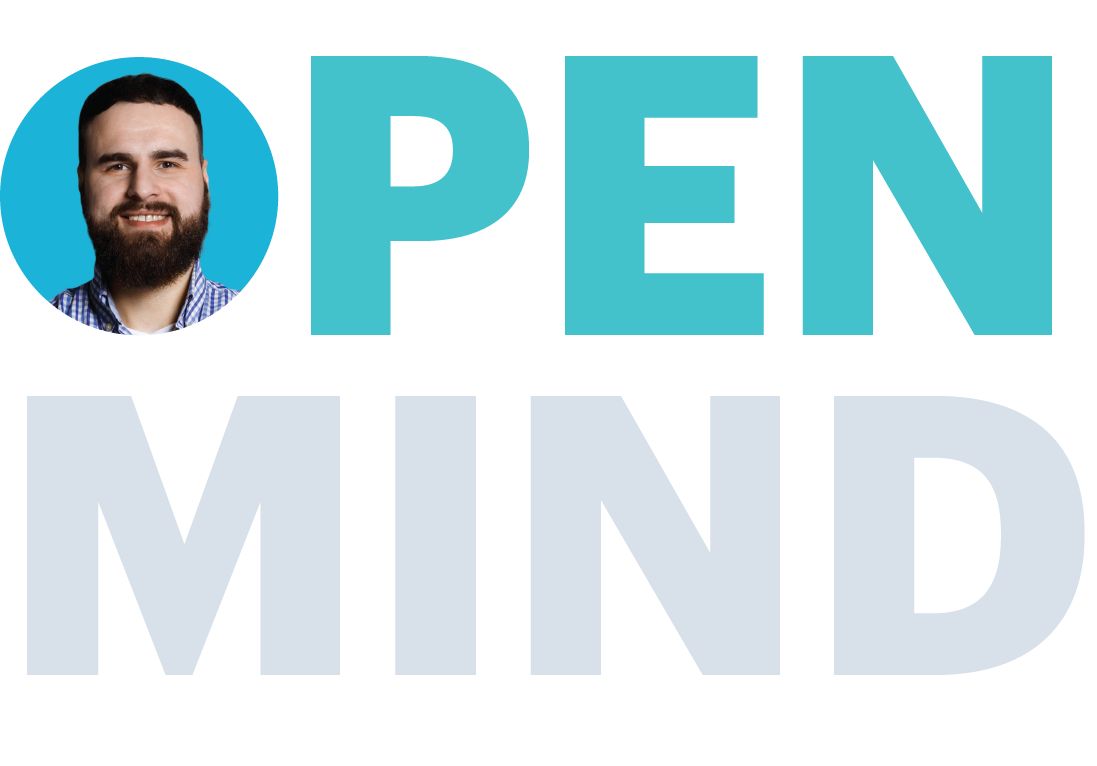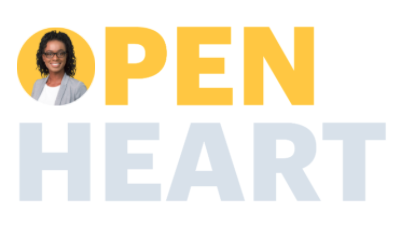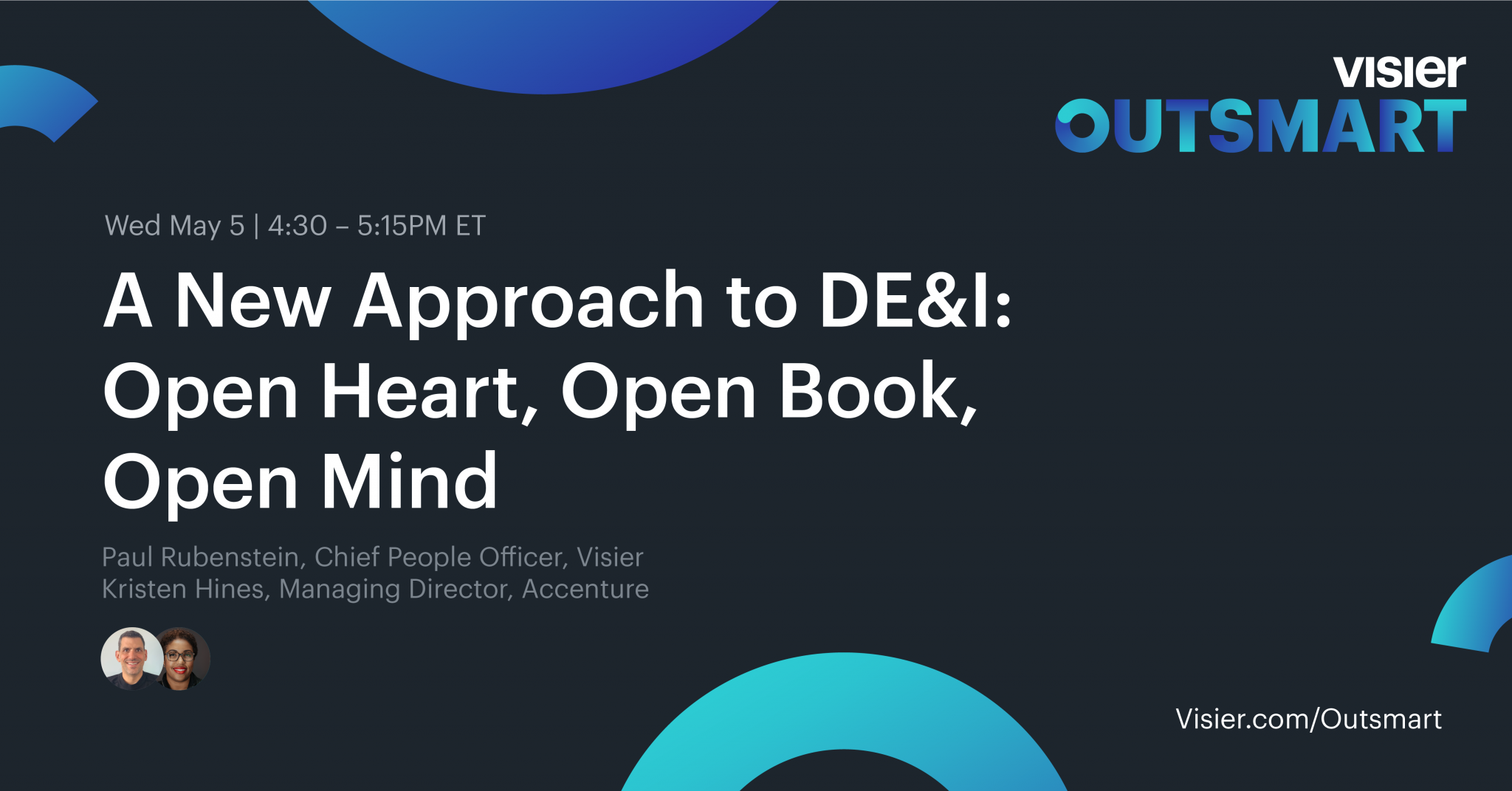Visier’s D&I Framework (Get Beyond Good Intentions, Part 1)
Visier is addressing D&I internally on several fronts: processes, data, and culture. Here’s why.

Outsmart, the leading people analytics and workforce planning conference, takes place online on May 5-6, 2021. It’s free to register so save your spot today! At Outsmart, the author of this article, Paul Rubenstien, Visier’s Chief People Officer, will lead a discussion with Kristen Hines, Managing Director, Accenture on the Open Heart, Open Book, Open Mind framework. Come back everyday leading up to the conference for more great insights like this. Enjoy!
100 mid-level people managers can have a bigger impact on workforce diversity than 10 C-level executives. But C-level executives (and some HR people) are more likely to regularly encounter diversity data than the people on the frontlines of hiring, promotion, and development decisions.
I’ll pose that as a question: Who is more likely to use diversity data in their people decisions: A manager who hears about diversity once a year in a town hall, or an executive who reports to the board on diversity 12 times a year?
Our choices are shaped by the signals we receive, and the managers who make day-to-day people decisions tend to default to the priorities that show up in the last, or next, results they have to explain. Accountability is shaped by the connection between our actions and how it shows up in company results. Organizations drive behaviors and accountability at a granular level with financial results, but are reluctant to do this with D&I data.
This reluctance to set numerical goals for diversity and be transparent with data is rooted in a past defined by avoiding risk. In my previous role as a management consultant, I often heard business leaders say things like “we have to do diversity training so we don’t get sued” or “we can’t share our diversity data because it will expose us.” This is not the way to achieve lasting progress, and this mindset must change. In the wake of protests against social injustice, this is changing—quickly.
All business leaders need to step up now for D&I
As the Wall Street Journal reports, in September 2020, only 14 US-based companies were making their EEOC data public. By March 2021, 54 companies had either shared—or committed to sharing—these reports. New SEC human capital reporting guidelines are flexible in terms of requirements, but a study published in December 2020 found that 54% of the disclosures described D&I.
Clearly, the events of the past several months have forced a change in attitudes about diversity data. Shareholders, customers, and employees judge how committed a company is to making progress by its willingness to share and report on its own representation levels. This, along with a general trend towards openness and transparency, means leaders who hide their numbers are becoming the exception—not the norm.
At the same time, there are mounting levels of frustration within leadership teams. There is little joy for the CEO who walks into the board year after year describing well-intended investments around employee training and targeted hiring, but shows up short in the category of meaningful progress. C-suite leaders can’t be involved in every decision, and have fallen short in their ability to influence hiring and promotion decisions that happen 3 or 4 levels further down the hierarchy.
But we are experiencing a transparency tipping point, and this gives me hope as a first-time Chief People Officer. Data can serve as an objective source of truth, and sharing numbers about gaps and progress can be a huge motivator. Even reporting on a lack of improvement drives accountability—evidence of no change is a driver of change.

It’s time to level up your approach to D&I data
Visier is not immune to Diversity and Inclusion challenges. For example, we need more women in management roles. Knowing and showing a gap is not enough. Visier has a culture of transparency around data, but establishing a desired end-state as a company objective brought with it questions about how to drive the right behaviors in pursuit of an outcome–and how best to approach accountability.
Leaders have no issue being public about the sales performance of different teams. It’s time to do the same with people managers and their talent decisions.
This can be done in a positive manner that isn’t just performative. Instead, it’s a practice where valuing talent AND diversity becomes the norm. The dark side of inauthentic (and unsustainable) diversity outcomes can be avoided. I outline this in detail through a discussion of targets (where accountability is diffused), goals (where accountability can be pinpointed), and quotas (something we avoid at Visier) in Part 2 of this article.
But while sharing representation numbers is important, a general number around representation won’t really move the needle.

Digging deeper into your data creates real change
It’s not enough to say “we need more women.” Organizations have to say “where, when, and why” workforce representations gaps are created and persist. If individual decision makers can’t connect their hiring and promotion practices to outcomes, then they will continue to run on auto-pilot. A general company number allows the outcome to be “somebody else’s problem.”
Diversity as a measure of workforce representation is not the only thing that organizations can measure. Our digital footprint has expanded to the point where even inclusion can now be measured—we can understand who really gets invited to participate in meetings and what our networks look like. Experience measurement can tell us when the moments of inclusion happen, and how attitudes and behaviors are shaped by leaders’ communications, town halls, development moments, and other employee lifecycle moments.
And by the way, it’s the combination of the data from your HR systems, sales systems, performance systems, and applicant tracking systems—along with market data—that really gives you the best picture. Running reports on HR transactions will provide numbers, but not insight into why the representation of women is low or why the turnover of minority employees is high.
For an organization to become truly transformational and tear down D&I barriers, then, it must fire on all cylinders, growing in maturity on three fronts: talent processes, data, and culture.
I have witnessed organizations spend time and money without moving the needle on workforce representation and even worse, create situations where the authenticity of efforts is questioned in the absence of visible change.
Efforts to address diversity and inclusion issues are dominated by three approaches:
Changing mindsets
Changing practices
Changing culture
These usually rely on individuals ‘doing the right thing’. Those not ready to change can opt out or rely on others to foster inclusion or make talent decisions that move the needle on outcome. Sadly, at the end of the year, most organizations reflect on their workforce composition changes and ask: Why didn’t we hit our goals? Who should we hold accountable?
At Visier, we believe that data can be used to drive changes in the behaviors guiding the moments that determine workforce representation and shape the dialog of a community that supports inclusion. We set out to combine the practices that shape individual talent decisions with the culture that fosters inclusion through the use of data.
Framework for D&I progress to connect intention and accountability

The framework presented below is called “Open Mind, Open Book, Open Heart.” It collects existing practices around D&I into a framework, and fills in the missing pieces around using data to pinpoint and close workforce representation gaps.
The approach doesn’t just use data to drive accountability; it also helps answer critical questions: Do we all have an objective view of the challenge? Are program investments changing outcomes? Are spoken “good intentions” turning into actions? How can data shape everyone’s dialog around diversity, equity, and inclusion?
This is what the framework looks like in practice:
1. Open Mind: Making the unconscious conscious

There are many barriers to achieving a diverse and inclusive workplace. Some impediments are historical and possibly unintentional; many can be traced back to 1970s employment approaches that still inform some HR practices. Other challenges are part of the human condition—we all come to work with a different set of experiences and an uneven level of empathy or agility in navigating cultures that are unfamiliar to us.
Open Mind includes many well-known D&I practices. These are practices focused on addressing process-based bias, as well as elevating everyone’s awareness and personal responsibility for fairness and justice in the workplace. Open Mind is organized in two groups:
Open Mind processes
These are familiar practices to reduce bias and create fair, transparent approaches to hiring and promotion. The goal is to turn auto-pilot reflexes and historical programs into conscious decisions that eliminate barriers.
We have long observed talent practices rooted more in tradition than proven science. Consider employee referrals, for example. This continues to be a revered tactic for acquiring talent, but if not executed with care, it can hurt diversity efforts.
Full Accessibility Sourcing
Inclusive recruiting website content
Gender-neutral job descriptions
Diversity in candidate sources and outreach
Diversity in boolean searches
Pipeline, slate diversity, and fallout data tracking
Conscious Hiring
Structure and standards for interviews
Interview training (don’t assume everyone is good at this)
Published expectations for candidates
Documented feedback from interviewers
Equal footing for referrals & external recruits
Diverse interview panels
Conscious Advancement
Clear expectations for job levels
Internal posting for all positions
Active networking, exploratory interviews
Formal career development plans
Formal mentor programs
Open Mind personal development programs
These programs elevate personal awareness, create empathy for the challenges that others face, and connect people to the value of a diverse workforce. Invest in setting expectations for how to operate in your culture, and give employees the tools to understand and manage the automatic scripts that fuel their judgments about other people. Help people understand (and manage) their own biases and let them know what they are accountable for in the workplace.
Unconscious Bias Testing and Training
Training to help people get in touch with their own bias and understand their personal responsibility for ensuring fairness and inclusion
Anti-Racism Training
This is an emerging practice that emphasizes an active approach to addressing behaviors in the workplace that work against inclusion, belonging, and (ultimately) the progress of the business
Diversity & Inclusion Training
Programs that help people unlock an intrinsic connection to a more diverse and inclusive workplace. They should also help people understand how diversity impacts growth, innovation, and overall success as a company
2. Open Book: A rhythm of insights and accountability

Open Book accelerates changes in workforce representation and inclusivity in culture through the transparent use of data. This gives everyone the same objective view of gaps and progress around D&I. Only then can people use your organization’s goals for change as a lens on their everyday decisions around things like hiring, promotion, and behavior.
Open Book emphasizes analytics that predict outcomes based on the next set of hiring and promotion decisions. One size does not fit all when it comes to packaging insights around diversity. Community dialog should be shaped by content that brings together a common view. Individual employee content has to be local and specific enough that it can connect an imminent decision with an overall company mission. Open Book encompasses the following practices:
Open Book analytics standards
These ensure organizations can get ahead of issues and monitor the impact their efforts have on creating a diverse and inclusive workforce. EEOC in the US reporting is a nice start, but there is a greater richness to what can be measured around both diversity and inclusion.
Holistic Diversity & Inclusion Measurement
A “complete” picture of the different types of diversity and a privacy policy for proper use. Go beyond race and gender
Measure inclusion. Use Organization Network Analysis to hold a mirror up to people’s network. Find out who is stranded and not connected to others. Figure out who has meeting curation power and observe moments of inclusivity. It’s not a complete solution for measuring inclusion, but it’s a start
Use employee surveys for a balanced view of issues and progress (a way to balance loudest/quietest voices). Understand behaviors and attitudes to help design interventions. Apply demographics so that interventions can be targeted
Root Cause Analysis of Workforce Diversity Gaps
The real challenges often lurk below the surface. As LinkedIn reports, for example, 44.7% of its overall workforce is female, but female representation in tech roles is only 24%. This is why having the capability to slice and dice the data by career level, geography, or job function is crucial. Changing female representation is much easier when you know exactly where and when gaps are created and sustained.
Generally, there are three major practices we recommend:
Root cause analysis that pinpoints bottlenecks in hiring and promotion
Action plans for areas where gaps are not rational
Action plans and accountability for improvement
Setting accountability requires the use of targets (for workforce outcomes where accountability is diffuse) and goals (where specific actions can be taken and accountability clearly assigned).
Part 2 of this series includes a detailed approach to setting targets and goals, as well as performing root cause analysis. It also discusses the change issues related to accountability for D&I.
Open Book accountability standards
These practices for using people analytics to shape an organization’s dialog, inspire change, and drive accountability while grounding everyone in an objective reality.
Alongside Routine Financial Data
Just like the monthly P&L, it is important to create moments where everyone in the organization looks at the same data around progress towards a goal, reflects on progress, and course-corrects.
Just like the financial results, no organization or responsible party should be allowed to go more than one month without looking back and saying: Did we change? Why not? What should we do differently? (Again, more on this in Part 2). At a minimum we recommend:
Monthly for the CEO’s direct reports
Monthly at divisional leadership teams
In The Flow Of Work
We live in an age where data is presented to us in a rhythm designed to change behavior. Consider how people make different choices about spending if their bank account balance is shown to them when they are making a purchase. Bring diversity data into moments that matter to interrupt the status-quo. This is the way to connect individual moments to collective outcomes:
Before promotion cycles
Before and after bonus cycles
Pay equity review at comp cycle
At start and close of hiring process
Alongside succession planning
Alongside development program nomination
Internal Transparency
Sharing data internally sets the tone for everyone’s conversation around D&I. It builds an amazing foundation of trust across constituencies and elevates the community dialog
Annual update on pay equity to explain your process and commitment
Twice-yearly updates on your diversity progress and programs with Q&A, discussion
External Transparency
Sharing your challenges and progress externally can radically transform your recruiting efforts–and helps customers, community and partners understand your culture. It becomes another level of accountability for everyone, just like sharing earnings expectations. Turn the new SEC human capital reporting guidelines into a strategic advantage.
Create an annual report on diversity and make it available on your website
Find organizations that align with your values and make public commitments
Be public with our benchmarks and our POV on how to react to them (we at plan to do this here at Visier)
Rich insights and data transparency create the fertile ground for achieving aspirational D&I goals. In a busy world, exposure to the truth requires us to stop, reflect—and do something different.
3. Open Heart: Building a culture of trust

As much as I love data, D&I efforts won’t generate change if the focus is entirely on numbers. Open Heart is a set of practices that harness an organization’s social dialog and connect it to a company’s vision, values, and purpose. This is in pursuit of a culture of trust, where the opportunity to contribute and the recognition of performance is a productive narrative that is shaped by leaders who approach a charged subject fearlessly—and turn angst into constructive dialog.
Everyone has a part in creating a better workplace. A bottom-up/top-down approach brings together the individual responsibility of employees at every level into a supportive community. Leaders must lead, but they can’t do it alone. A community dialog, diversity advisory board or council is critical, whether or not you have a Chief Diversity Officer. When diversity is not run solely by HR, it is more likely to be accepted as a business priority.
We divide these programs into two main categories: leadership and community.
Open Heart leadership
This establishes structures to provide bi-directional guidance to the leadership team as well as empower individuals to champion a diverse and inclusive culture. Senior leaders who don’t just say the right things, but do the right things, set the tone for the entire organization. A change in representation takes time, but the perception of a fair and just workplace changes quickly, both good and bad, based on what leaders do and communicate.
Authentic Point of View
Statement of principles about what D&I means to a company’s leaders
Alignment of company values to reinforce an inclusive, diverse workplace
Code of expectations for people managers, employees, customers, applicants, and partners
Ambassador-Advisors
Not every company has a dedicated Diversity Officer. HR should not go it alone on this topic. At Visier, we use a standing group of volunteers who meet monthly with the CHRO. This group provides:
A quarterly formal update for the CEO
Active work as change leaders/champions of inclusive behaviors
Advice on changes to workplace practices
Communications help—connect people to programs
Open Heart community
Community, and the dialog about diversity and inclusion, create the foundation for connection, and ultimately belonging. It is the key to making D&I efforts tangible, visible, and accessible. These practices create the fertile landscape where new practices and accountability can thrive. Here are some practices to nurture community.
Rituals and Celebrations
A forum to acknowledge the challenge through compassion, outreach, and support. At Visier, we use a combination of town-halls, listening sessions and Q&A forums.
External Outreach
Promote your practices and aspirations externally. No one company has the magic answer to overcome historical bias and structural inequities in society. Only through the wisdom of many will we make the world better.
Support For Those Who Need More
“Share Our Stories” program (celebrating individuals and featuring the richness of what we each bring to work)
Accessible internal resources on diversity and inclusion for those who are just learning, or want to know more
Employee Resource Groups to bring together friends and allies
Compassionate avenues for escalating and resolving issues
An “ally” culture program and resources for building leaders as allies

Rise up to the challenge today
We have been talking about D&I for decades, but organizations often struggle with the same age-old issues. It doesn’t have to be this way. Change is never easy.
Ground your culture in data to build trust and accountability. Share challenges and progress. Connect individual talent decisions to a larger D&I strategy. Bring good intentions together with accountability for actions through transparency. This is the path to lasting, meaningful change.
Hear more from Paul on this topic at Outsmart on Wednesday, May 5 at 4:30-5:15pm EST in A New Approach to DE&I: Open Heart, Open Book, Open Mind, with Kristen Hines, Managing Director at Accenture. Register for the free digital conference today!



